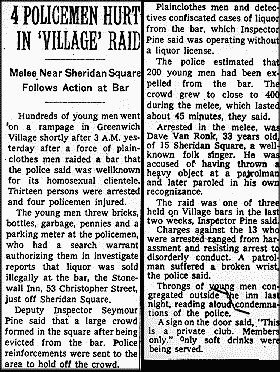Originally posted Feb. 11, 2009. Reposted in honor of the anniversary of the Stonewall Riots.
I found a collection of images relating to gay and lesbian studies put together at Columbia University, including this scan of a NYT article on what came to be known as the Stonewall Riots, when crowds reacted violently when police attempted to raid a club on June 28, 1969 (skirmishes continued for several days):

Graffiti from the Stonewall Riots (published in the Village Voice):

There are also some other good photos unrelated to Stonewall such as this one, from 1962, of entertainers at a drag club being hauled off by police after a raid:

The database might be useful if you’re interested in what is generally seen as the start of the gay rights movement.








